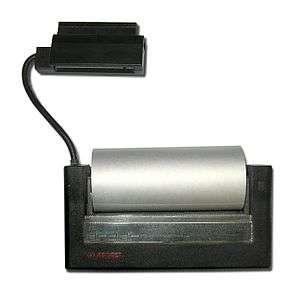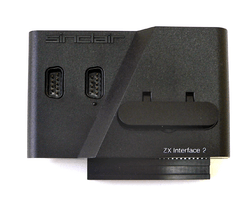ZX Spectrum
 An issue 2 1982 ZX Spectrum | |
| Developer | Sinclair Research Ltd |
|---|---|
| Manufacturer | Timex Corporation |
| Type | Home computer |
| Generation | 8-bit |
| Release date | United Kingdom: 23 April 1982 |
| Retail availability | 1982–1992 |
| Discontinued | 1992[1] |
| Units sold | 5 million (not including clones) |
| Media | Cassette tape, 3-inch floppy disk on Spectrum +3 |
| Operating system | Sinclair BASIC |
| CPU | Z80 @ 3.5 MHz and equivalent |
| Memory | 16 KB / 48 KB / 128 KB |
| Predecessor | ZX81 |
| Successor | QL |
The ZX Spectrum (UK /zɛd ɛks ˈspɛktrəm/) is an 8-bit personal home computer released in the United Kingdom in 1982 by Sinclair Research Ltd. It was manufactured in Dundee, Scotland, in the now closed Timex factory.[2]
Referred to during development as the ZX81 Colour and ZX82,[3][4] it was launched as the ZX Spectrum by Sinclair to highlight the machine's colour display, compared with the black and white of its predecessor, the ZX81.[5] The Spectrum was released as eight different models, ranging from the entry level with 16 KB RAM released in 1982 to the ZX Spectrum +3 with 128 KB RAM and built in floppy disk drive in 1987; together they sold in excess of 5 million units worldwide (not counting clones).[6]
The Spectrum was among the first mainstream-audience home computers in the UK, similar in significance to the Commodore 64 in the USA. The introduction of the ZX Spectrum led to a boom in companies producing software and hardware for the machine,[7] the effects of which are still seen;[1] some credit it as the machine which launched the UK IT industry.[8] Licensing deals and clones followed, and earned Clive Sinclair a knighthood for "services to British industry".[9]
The Commodore 64, Dragon 32, Oric-1 and Atmos, BBC Microcomputer and later the Amstrad CPC range were rivals to the Spectrum in the UK market during the early 1980s. Over 24,000 software titles have been released since the Spectrum's launch and new titles continue to be released—over 100 in 2012.[10] In 2014, a Bluetooth keyboard modelled on the Spectrum was announced.[11]
Hardware

The Spectrum is based on a Zilog Z80 A CPU running at 3.5 MHz (or NEC D780C-1 clone). The original model has 16 KB (16×1024 bytes) of ROM and either 16 KB or 48 KB of RAM. Hardware design was by Richard Altwasser of Sinclair Research, and the outward appearance was designed by Sinclair's industrial designer Rick Dickinson.[7]
Video output is through an RF modulator and was designed for use with contemporary portable television sets, for a simple colour graphic display. Text can be displayed using 32 columns × 24 rows of characters from the ZX Spectrum character set or from a set provided within an application, from a palette of 15 shades: seven colours at two levels of brightness each, plus black.[12] The image resolution is 256×192 with the same colour limitations.[13] To conserve memory, colour is stored separate from the pixel bitmap in a low resolution, 32×24 grid overlay, corresponding to the character cells. In practice, this means that all pixels of an 8x8 character block share one foreground colour and one background colour. Altwasser received a patent for this design.[14]
An "attribute" consists of a foreground and a background colour, a brightness level (normal or bright) and a flashing "flag" which, when set, causes the two colours to swap at regular intervals.[13] This scheme leads to what was dubbed colour clash or attribute clash, where a desired colour of a specific pixel could not necessarily be selected. This became a distinctive feature of the Spectrum, meaning programs, particularly games, had to be designed around this limitation. Other machines available around the same time, for example the Amstrad CPC or the Commodore 64, did not suffer from this limitation. The Commodore 64 used colour attributes in a similar way, but a special multicolour mode, hardware sprites and hardware scrolling were used to avoid attribute clash.[15]
Sound output is through a beeper on the machine itself, capable of producing one channel with 10 octaves. Software was later available that could play two channel sound. The machine includes an expansion bus edge connector and 3.5 mm audio in/out ports for the connection of a cassette recorder for loading and saving programs and data. The "ear" port can drive headphones and the "mic" port provides line level[16] audio out which could be amplified.
Firmware
The machine's Sinclair BASIC interpreter is stored in ROM (along with fundamental system-routines) and was written by Steve Vickers on contract from Nine Tiles Ltd. The Spectrum's chiclet keyboard (on top of a membrane, similar to calculator keys) is marked with BASIC keywords. For example, pressing "G" when in programming mode would insert the BASIC command GOTO.[17]
The BASIC interpreter was developed from that used on the ZX81 and a ZX81 BASIC program can be typed into a Spectrum largely unmodified, but Spectrum BASIC included many extra features making it easier to use. The ZX Spectrum character set was expanded from that of the ZX81, which did not feature lower-case letters. Spectrum BASIC included extra keywords for the more advanced display and sound, and supported multi-statement lines. The cassette interface was much more advanced, saving and loading around five times faster than the ZX81 (1500 bits per second compared to 307),[18] and unlike the ZX81, the Spectrum could maintain the TV display during tape storage and retrieval operations. As well as being able to save programs, the Spectrum could save the contents of arrays, the contents of the screen memory, and the contents of any defined range of memory addresses.
Sinclair Research models
Pre-production designs
Rick Dickinson came up with a number of designs for the "ZX82" project before the final ZX Spectrum design. A number of the keyboard legends changed during the design phase including ARC becoming CIRCLE, FORE becoming INK and BACK becoming PAPER.[4] The Spectrum reused a number of design elements of the ZX81: The ROM code for things such as floating point calculations and expression parsing were very similar (with a few obsolete ZX81 routines left in the Spectrum ROM). The simple keyboard decoding and cassette interfaces were nearly identical (although the latter was now programmed to load/save at a higher speed). The central ULA integrated circuit was somewhat similar although it implemented the major enhancement over the ZX81: A (fully) hardware based television raster generator (with colour) that indirectly gave the new machine approximately four times as much processing power as the ZX81, simply due to the Z80 now being released from this video generation task. A bug in the ULA as originally designed meant that the keyboard did not always scan correctly, and was rectified by a "dead cockroach" (a small circuit board mounted upside down next to the CPU) for Issue 1 ZX Spectrums.[19]
ZX Spectrum 16K/48K

The original ZX Spectrum is remembered for its rubber keyboard, diminutive size and distinctive rainbow motif. It was originally released on 23 April 1982[21] with 16 KB of RAM for £125 or with 48 KB for £175;[22] these prices were later reduced to £99 and £129 respectively.[23] Owners of the 16 KB model could purchase an internal 32 KB RAM upgrade, which for early "Issue 1" machines consisted of a daughterboard. Later issue machines required the fitting of 8 dynamic RAM chips and a few TTL chips. Users could mail their 16K Spectrums to Sinclair to be upgraded to 48 KB versions. Later revisions contained 64 KB of memory but were configured such that only 48 KB were usable.[24] External 32 KB RAM packs that mounted in the rear expansion slot were available from third parties. Both machines had 16 KB of onboard ROM.
About 60,000 "Issue 1" ZX Spectrums were manufactured; they can be distinguished from later models by the colour of the keys (light grey for Issue 1, blue-grey for later models).[25]
The Sinclair models featured audio line in and out, in the form of an "ear" and "mic" socket. An external tape recorder was needed to load the majority of software released. Either socket could be connected to headphones or an amplifier as an audio output, although this would not disable the internal speaker.
ZX Spectrum+
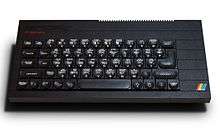
Planning of the ZX Spectrum+ started in June 1984,[26] and it was released in October the same year.[27] This 48 KB Spectrum (development code-name TB[26]) introduced a new QL-style case with an injection-moulded keyboard and a reset button that was basically a switch that shorted across the CPU reset capacitor. Electronically, it was identical to the previous 48 KB model. It was possible to change the system boards between the original case and the Spectrum+ case. It retailed for £179.95.[28] A DIY conversion-kit for older machines was available. Early on, the machine outsold the rubber-key model 2:1;[26] however, some retailers reported a failure rate of up to 30%, compared with a more usual 5–6% for the older model.[27]
ZX Spectrum 128
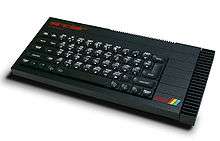
Sinclair developed the ZX Spectrum 128 (code-named Derby) in conjunction with their Spanish distributor Investrónica.[29] Investrónica had helped adapt the ZX Spectrum+ to the Spanish market after the Spanish government introduced a special tax on all computers with 64 KB RAM or less,[30] and a law which obliged all computers sold in Spain to support the Spanish alphabet and show messages in Spanish.[31]
The appearance of the ZX Spectrum 128 was similar to the ZX Spectrum+, with the exception of a large external heatsink for the internal 7805 voltage regulator added to the right hand end of the case, replacing the internal heatsink in previous versions.
New features included 128 KB RAM, three-channel audio via the AY-3-8912 chip, MIDI compatibility, an RS-232 serial port, an RGB monitor port, 32 KB of ROM including an improved BASIC editor, and an external keypad.
The machine was simultaneously presented for the first time and launched in September 1985 at the SIMO '85 trade show in Spain, with a price of 44,250 pesetas. Because of the large number of unsold Spectrum+ models, Sinclair decided not to start selling in the UK until January 1986 at a price of £179.95.[32] No external keypad was available for the UK release, although the ROM routines to use it and the port itself remained.
The Z80 processor used in the Spectrum has a 16-bit address bus, which means only 64 KB of memory can be directly addressed. To facilitate the extra 80 KB of RAM the designers used bank switching so the new memory would be available as eight pages of 16 KB at the top of the address space. The same technique was used to page between the new 16 KB editor ROM and the original 16 KB BASIC ROM at the bottom of the address space.[33]
The new sound chip and MIDI out abilities were exposed to the BASIC programming language with the command PLAY and a new command SPECTRUM was added to switch the machine into 48K mode, keeping the current BASIC program intact (although there is no way to switch back to 128K mode). To enable BASIC programmers to access the additional memory, a RAM disk was created where files could be stored in the additional 80 KB of RAM. The new commands took the place of two existing user-defined-character spaces causing compatibility problems with certain BASIC programs.[34]
The ZX Spectrum 128 had no internal speaker, unlike its predecessors. Sound was produced from the television speaker instead.[35]
The Spanish version had the "128K" logo in white; the British one had the same logo in red.
Amstrad models
ZX Spectrum +2

The ZX Spectrum +2 was Amstrad's first Spectrum, coming shortly after their purchase of the Spectrum range and "Sinclair" brand in 1986. The machine featured an all-new grey case featuring a spring-loaded keyboard, dual joystick ports, and a built-in cassette recorder dubbed the "Datacorder" (like the Amstrad CPC 464), but was in most respects identical to the ZX Spectrum 128. The main menu screen lacked the Spectrum 128's "Tape Test" option, and the ROM was altered to account for a new 1986 Amstrad copyright message. These changes resulted in minor incompatibility problems with software that accessed ROM routines at certain addresses. Production costs had been reduced and the retail price dropped to £139–£149.[36]
The new keyboard did not include the BASIC keyword markings that were found on earlier Spectrums, except for the keywords LOAD, CODE and RUN which were useful for loading software. This was not a major issue, as the +2 boasted a menu system, almost identical to the ZX Spectrum 128, where one could switch between 48K BASIC programming with the keywords, and 128K BASIC programming in which all words (keywords and otherwise) must be typed out in full (although the keywords are still stored internally as one character each). Despite these changes, the layout remained identical to that of the 128.[37]
The ZX Spectrum +2 power supply was a grey version of the ZX Spectrum+ and 128 power supply.[38]
ZX Spectrum +2A

The ZX Spectrum +2A was a variant of the Spectrum +3, housed inside a black version of the Spectrum +2 case mouldings. The Spectrum +2A/+3 motherboard (AMSTRAD part number Z70830) was designed such that it could be assembled without the floppy disk controller or associated logic and a +2 style "datacorder" connected.[39] Originally, Amstrad planned to introduce an additional disk interface for the +2A/+2B called the AMSTRAD SI-1,[40] but it never appeared. If an external disk drive was added, the "+2A" on the system OS menu would change to a +3.
The power supply of the ZX Spectrum +2A used the same pinout as the +3. The power supply purchased with the +2A/B had "Sinclair +2" written on the case.[41]
ZX Spectrum +3

The ZX Spectrum +3 looked similar to the +2 but featured a built-in 3-inch floppy disk drive (like the Amstrad CPC 6128) instead of the tape drive, and was in a black case. It was launched in 1987, initially retailed for £249[42] and then later £199[43] and was the only Spectrum capable of running the CP/M operating system without additional hardware.
The +3 saw the addition of two more 16 KB ROMs. One was home to the second part of the reorganised 128 ROM and the other hosted the +3's disk operating system. This was a modified version of Amstrad's PCWDOS (the disk access code used in LocoScript), called +3DOS. These two new 16 KB ROMs and the original two 16 KB ROMs were now physically implemented together as two 32 KB chips. To be able to run CP/M, which requires RAM at the bottom of the address space, the bank-switching was further improved, allowing the ROM to be paged out for another 16 KB of RAM.
Such core changes brought incompatibilities:
- Removal of several lines on the expansion bus edge connector (video, power, and IORQGE); caused many external devices problems; some such as the VTX5000 modem could be used via the "FixIt" device.
- Dividing ROMCS into 2 lines, to disable both ROMs
- Reading a non-existent I/O port no longer returned the last attribute; caused certain games such as Arkanoid to be unplayable
- Memory timing changes; certain RAM banks were now contended causing high-speed colour-changing effects to fail
- The keypad scanning routines from the ROM were removed
- move 1 byte address in ROM
Some older 48K and 128K games were incompatible with the machine. The ZX Interface 1 was incompatible due to differences in ROM and expansion connector, making it impossible to connect and use the Microdrive units.[44]
There was a regression in sound quality from the previous 128K models – an error with a resistor placement meant sound was distorted.[45]
The ZX Spectrum +3 power supply provides the same voltages as the one supplied with +2A/B. This power supply has the same DIN connector so can be used with the +2A/B. The power supply purchased with the +3 had "Sinclair +3" written on the case.[46]
Production of the +3 ceased in December 1990, believed to be in response for Amstrad relaunching their CPC range. At the time, it was estimated about 15% of ZX Spectrums sold had been +3 models. Production of the +2B (the only other model then still in production) continued, as it was believed not to be in competition with other computers in Amstrad's product range.[47] It was discontinued in 1992.[1]
ZX Spectrum +2B and +3B
The ZX Spectrum +2B and ZX Spectrum +3B were functionally similar in design to the Spectrum +2A and +3.[48] The main electronic differences being changes to the generation of the audio output signal to resolve problems with clipping.
Unlike the +2A and +3, the Spectrum +2B and +3B do not share a common motherboard. The +2B board (AMSTRAD part number Z70833) has no provision for floppy disk controller circuitry and the +3B motherboard (Amstrad part number Z70835) has no provision for connecting an internal tape drive.
Clones
Official clones
Sinclair licensed the Spectrum design to Timex Corporation in the United States. An enhanced version with better sound, graphics and other modifications was marketed in the USA by Timex as the Timex Sinclair 2068. Timex's derivatives were largely incompatible with Sinclair systems. Some of the Timex innovations were later adopted by Sinclair Research. A case in point was the abortive Pandora portable Spectrum, whose ULA had the high resolution video mode pioneered in the TS2068. Pandora had a flat-screen monitor and Microdrives and was intended to be Sinclair's business portable. After Amstrad bought the computer business of Sinclair Research, Sir Clive retained the rights to the Pandora project, and it evolved into the Cambridge Computer Z88, launched in 1987.[49]
In India, Decibells Electronics introduced a licensed version of the Spectrum+ in 1986. Dubbed the "db Spectrum+", it did reasonably well in the Indian market and sold many units until 1990, when the market died away.[50]
The ZX Spectrum Vega and its planned follow-up, the ZX Spectrum Vega+ are modern redesigns of the ZX Spectrum in the form of a handheld TV game and a handheld game console respectively.[51][52]
Unofficial clones
Unofficial Spectrum clones were produced, especially in the former Eastern Bloc countries (e.g. in Romania, several models were produced (Tim-S, HC85, HC91, Cobra, Junior, CIP, CIP 3, Jet), some featuring CP/M and a 5.25"/3.5" floppy disk) and South America (e.g. Microdigital TK90X and TK95). In the Soviet Union, ZX Spectrum clones were assembled by thousands of small start-ups and distributed through poster ads and street stalls. Over 50 such clone models existed.[53] Some of them are still being produced, such as the Pentagon and ATM Turbo.
In the UK, Spectrum peripheral vendor Miles Gordon Technology (MGT) released the SAM Coupé as a potential successor with some Spectrum compatibility. By this point, the Commodore Amiga and Atari ST had taken hold of the market, leaving MGT in eventual receivership.[54]
Peripherals
Several peripherals were marketed by Sinclair: the ZX Printer was already on the market,[55] as the ZX Spectrum expansion bus was partially backwards-compatible with that of the ZX81.
The ZX Interface 1 add-on module included 8 KB of ROM, an RS-232 serial port, a proprietary LAN interface (called ZX Net), and an interface for the connection of up to eight ZX Microdrives – somewhat unreliable but speedy tape-loop cartridge storage devices released in July 1983.[56][57] These were used in a revised version on the Sinclair QL, whose storage format was electrically compatible but logically incompatible with the Spectrum's. Sinclair also released the ZX Interface 2 which added two joystick ports and a ROM cartridge port.[58]
There were a plethora of third-party hardware addons. The better known of these included the Kempston joystick interface, the Morex Peripherals Centronics/RS-232 interface, the Currah Microspeech unit (speech synthesis),[59] Videoface Digitiser,[60] RAM pack, the Cheetah Marketing SpecDrum,[61] a drum machine, and the Multiface,[62] a snapshot and disassembly tool from Romantic Robot. Keyboards were especially popular in view of the original's notorious "dead flesh" feel.[63]
There were disk drive interfaces, such as the Abbeydale Designers/Watford Electronics SPDOS, Abbeydale Designers/Kempston KDOS and Opus Discovery. The SPDOS and KDOS interfaces were the first to come bundled with office productivity software (Tasword Word Processor, Masterfile database and Omnicalc spreadsheet). This bundle, together with OCP's Stock Control, Finance and Payroll systems, introduced small businesses to a streamlined, computerised operation. The most popular floppy disk systems (except in East Europe) were the DISCiPLE and +D systems released by Miles Gordon Technology in 1987 and 1988 respectively. Both systems had the ability to store memory images onto disk snapshots could later be used to restore the Spectrum to its exact previous state. They were both compatible with the Microdrive command syntax, which made porting existing software much simpler.[64]
During the mid-1980s, Telemap Group Ltd launched a fee-based service allowing users to connect their ZX Spectrums via a Prism Micro Products VTX5000 modem to a viewdata service known as Micronet 800, hosted by Prestel, which provided news and information about microcomputers. The service allowed a form of instant messaging and online shopping.[65]
Software
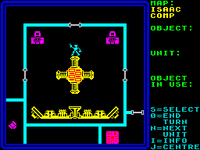
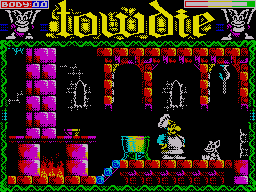
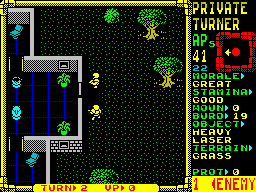
As of July 2012, over 24,000 titles had been released for the Spectrum family.[66] While most of these are games, the library includes programming language implementations, databases (e.g. VU-File[67]), word processors (e.g. Tasword II[68]), spreadsheets (e.g. VU-Calc[67]), drawing and painting tools (e.g. OCP Art Studio[69]), and even 3D-modelling (e.g. VU-3D[70][71]) and archaeology software[72] amongst many other types.[73]
The early Spectrum models' great success as a games platform came in spite of its lack of built-in joystick ports, primitive sound generation, and colour support that was optimised for text display:[74] the hardware limitations of the platform required a particular level of creativity from video game designers.[75]
A simulation program called Evolution,[76] commonly known as Foxes and Rabbits, came with the Spectrum. The logic was that too small a population of rabbits would provide insufficient food for foxes whose numbers would then decline, until too few foxes would result in the rabbit population again increasing, and the cycle would continue. One nominated a number of rabbits and number of foxes to start, then watched the basic graph of the two populations rising and falling. At any point in time, one could pause the simulation and save to the audio cassette by pressing 'Record' on the connected remote tape recorder, then later resume the simulation on the Spectrum from that point.
According to the 90th issue of the British gaming magazine GamesMaster, the ten biggest games released were (in descending order) Head Over Heels, Jet Set Willy, Skool Daze, Renegade, R-Type, Knight Lore, Dizzy, The Hobbit, Way Of The Exploding Fist, and Match Day 2.[77]
Distribution
Most Spectrum software was originally distributed on audio cassette tapes. The Spectrum was intended to work with a normal domestic cassette recorder,[78] and despite differences in audio reproduction fidelity, the software loading process was quite reliable and faster than on competing systems of the time, but slow by modern standards.
Although the ZX Microdrive was initially greeted with good reviews,[79] it never took off as a distribution method due to worries about the quality of the cartridges and piracy.[80] Hence the main use became to complement tape releases, usually utilities and niche products like the Tasword word processing software and Trans Express, (a tape to microdrive copying utility). No games are known to be exclusively released on Microdrive.
Although the Interface 2 proved popular, the high cost of ROM cartridges meant that very few titles were released in this format.[81]
Despite the popularity of the DISCiPLE and +D systems, most software released for them took the form of utility software. The ZX Spectrum +3 enjoyed much more success when it came to commercial software releases on floppy disk. More than 700 titles were released on 3-inch disk from 1987 to 1997.[66]
Software was distributed through print media; magazines[82] and books.[83] The reader would type the Sinclair BASIC program listing into the computer by hand, run it, and could save it to tape for later use. Software distributed in this way was in general simpler and slower than its assembly language counterparts. Magazines printed long lists of checksummed hexadecimal digits with machine code games or tools.
Another software distribution method was to broadcast the audio stream from the cassette on another medium and have users record it onto an audio cassette themselves. In radio or television shows in many European countries, the host would describe a program, instruct the audience to connect a cassette tape recorder to the radio or TV and then broadcast the program over the airwaves in audio format.[84] Some magazines distributed 7" 33⅓ rpm flexidisc records, a variant of regular vinyl records which could be played on a standard record player.[85] These disks were known under various trademarked names including "Floppy ROM", "Flexisoft", and "Discoflex".
Copying and backup
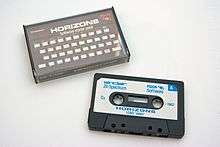
Many copiers—utilities to copy programs from audio tape to another tape, microdrive tapes, and later on diskettes—were available for the Spectrum. As a response to this, publishers introduced copy protection measures to their software, including different loading schemes.[86] Other methods for copy prevention were also used including asking for a particular word from the documentation included with the game—often a novella such as the Silicon Dreams trilogy—or another physical device distributed with the software—e.g. Lenslok as used in Elite, or the colour-code chart included with Jet Set Willy. Special hardware, such as Romantic Robot's Multiface, was able to dump a copy of the ZX Spectrum RAM to disk/tape at the press of a button, entirely circumventing the copy protection systems.
Most Spectrum software has been converted to current media and is available for download. One popular program for converting Spectrum files from tape is Taper; it allows connecting a cassette tape player to the line in port of a sound card, or—through a simple home-built device—to the parallel port of a PC.[87] Once in files on a host machine, the software can be executed on an emulator.
Community
The ZX Spectrum enjoyed a very strong community early on. Several dedicated magazines were released including Sinclair User (1982), Your Spectrum (1983), rebranded as Your Sinclair in 1986, and CRASH (1984). Early on they were very technically oriented with type-in programs and machine code tutorials. Later on they became almost completely game-oriented. Several general contemporary computer magazines covered the ZX Spectrum in more or less detail. They included Computer Gamer, Computer and Video Games, Computing Today, Popular Computing Weekly, Your Computer and The Games Machine.[88]
The Spectrum is affectionately known as the Speccy by elements of its fan following.[89]
More than 80 electronic magazines existed, many in Russian. Most notable of them were AlchNews (UK), ZX-Format (Russia), Adventurer (Russia) and Spectrofon (Russia).
Notable developers
A number of notable games developers began their careers on the ZX Spectrum, including David Perry of Shiny Entertainment, and Tim and Chris Stamper (founders of Rare, formerly Ultimate Play The Game, maker of many games for Nintendo and Microsoft game consoles). Other prominent games developers include Julian Gollop (Chaos, Rebelstar, X-COM series), Matthew Smith (Manic Miner, Jet Set Willy), Jon Ritman (Match Day, Head Over Heels), Jonathan "Joffa" Smith (Ping Pong, Batman: The Caped Crusader, Mikie, Hyper Sports), The Oliver Twins (the Dizzy series), Clive Townsend (Saboteur), Sandy White (Ant Attack; I, of the Mask), Pete Cooke (Tau Ceti), Mike Singleton (The Lords of Midnight, War In Middle Earth), and Alan Cox.[90] Although the 48K Spectrum's audio hardware was not as capable as chips in other popular 8-bit home computers of the era, computer musicians David Whittaker and Tim Follin produced notable multi-channel music for it.
Jeff Minter ported some of his Commodore VIC-20 games to the ZX Spectrum.[91]
Reception
BYTE in January 1983 acknowledged the appeal of the Spectrum's low £125 price to British consumers and called it a "promising machine". It criticised the keyboard; "inexpensive or not, the ... layout is impossible to justify ... poorly designed in several respects". The review was skeptical of the computer's appeal to American consumers if sold for US$220—"hardly competitive with comparable low-cost American units"—and expected that Timex would sell it for $125–150.[92]
Legacy
On 23 April 2012, a Google doodle honoured the 30th anniversary of the Spectrum. As it coincided with St George's Day, the logo was of St George fighting a dragon in the style of a Spectrum loading screen.[93]
In January 2014, Elite Systems, who produced a successful range of software for the original ZX Spectrum in the 1980s, announced plans for a Spectrum-themed bluetooth keyboard that would attach to mobile devices such as the iPad.[94][95] The company provided a crowdfunding campaign in order to fund the project, which would be compatible with games already released on iTunes and Google Play.[96] Elite Systems took down its Spectrum Collection application the following month, due to complaints from authors of the original 1980s game software that they had not been paid for the content.[97] Later that year, a £100 Sinclair ZX Spectrum Vega retro video game console was announced by Retro Computers and crowdfunded on IndieGogo, with the apparent backing of Clive Sinclair as an investor,[98] but without a full keyboard and manufactured in a limited capacity.[99]
See also
- List of computer system emulators § Sinclair ZX Spectrum and clones
- List of ZX Spectrum games
- ZX Spectrum graphic modes
- ZX Spectrum Contended Memory
References
- 1 2 3 BBC News (23 April 2007). "How the Spectrum began a revolution". Portland Place, London, W1A 1AA, England, UK: British Broadcasting Corporation of Broadcasting House. Archived from the original on 12 January 2009. Retrieved 31 March 2015.
The Spectrum's reign as the UK's most popular computer was brief but its legacy and the affection in which it is held remains to this day.
- ↑ Day, Peter. "How Dundee became a computer games centre". BBC News. BBC. Retrieved 12 November 2016.
- ↑ Dickinson, Rick (2007-07-02). "specLOGO02 (ZX81 Colour devel.)". Sinclair Spectrum development. Archived from the original on 30 March 2014. Retrieved 2 April 2015.
Graphics naming study – seemed logical to call the Spectrum the colour version of the ZX81
- 1 2 Dickinson, Rick (2 July 2007). "specModel01 (ZX82 devel.)". Sinclair Spectrum development. Archived from the original on 17 December 2013. Retrieved 2 April 2015.
Early model, all black with dark blue keys, not even the Sinclair logo, or colour reference – must have been a minimalist attempt
- ↑ Klooster, Erik. "SINCLAIR ZX SPECTRUM : the good, old 'speccy'". Computer Museum. Retrieved 19 April 2006.
- ↑ "Videogaming: The Odyssey". EDGE Magazine. Future Publishing: 76. January 2000.
- 1 2 Owen, Chris. "ZX Spectrum 16K/48K". Planet Sinclair. Retrieved 14 September 2008.
- ↑ Williams, Chris (23 April 2007). "Sinclair ZX Spectrum: 25 today". Register Hardware. Situation Publishing. Retrieved 14 September 2008.
- ↑ Owen, Chris. "ZX Spectrum". Planet Sinclair. Retrieved 14 September 2008.
- ↑ "List of ZX Spectrum titles released in 2012". World of Spectrum. Retrieved 29 April 2013.
- ↑ "The Recreated Sinclair ZX Spectrum". Elite Systems. Retrieved 16 July 2015.
- ↑ Vickers, Steven (1982). "Introduction". Sinclair ZX Spectrum BASIC Programming. Sinclair Research Ltd. Retrieved 23 August 2006.
- 1 2 Vickers, Steven (1982). "Colours". Sinclair ZX Spectrum BASIC Programming. Sinclair Research Ltd. Retrieved 23 August 2006.
- ↑ EP patent 0107687, Richard Francis Altwasser, "Display for a computer", issued 6 July 1988, assigned to Sinclair Research Ltd
- ↑ "Face off – ZX Spectrum vs Commodore 64". Eurogamer. 29 April 2012. Retrieved 28 August 2012.
- ↑ Vickers, Steven. "BEEP". Sinclair ZX Spectrum BASIC Programming. Sinclair Research Ltd.
- ↑ Vickers, Steven (1982). "Basic programming concepts". Sinclair ZX Spectrum BASIC Programming. Sinclair Research Ltd. Retrieved 19 September 2006.
- ↑ "Tape Data Storage". Retrieved 19 August 2012.
- ↑ "The Sinclair Story, Part 2". Crash (16): 127. May 1985.
- 1 2 Stratford, Christopher (11 May 2014). "The Home Computers Hall of Fame, The Machines". gondolin.org.uk. Archived from the original on 17 March 2015. Retrieved 31 March 2015.
By modern standards, these machines were primitive, but there was something about them that made them far more enjoyable than the current selection (or lack thereof).
- ↑ Warman, Matt (23 April 2012). "ZX Spectrum at 30: the computer that started a revolution". The Telegraph. 111 Buckingham Palace Road, London, SW1W 0DT, England, UK: Telegraph Media Group Limited. Archived from the original on 8 March 2013. Retrieved 31 March 2015.
It was the computer that introduced a generation to video gaming, helped to earn Sir Clive Sinclair a knighthood and even made programming cool: the ZX Spectrum has a lot to answer for.
- ↑ "The High Street Spectrum" (PDF). ZX Computing: 43. February 1983. Retrieved 27 April 2016.
- ↑ "News: Spectrum prices are slashed". Sinclair User (15): 13. June 1983. Archived from the original on 22 February 2012. Retrieved 15 August 2006.
The move is expected to cause chaos in the home computer market. It is believed the reductions were prompted by competition which, while it is not yet a serious threat, is thought to be growing quickly.
- ↑ Goodwin, Simon (September 1984). "Suddenly, it's the 64K Spectrum!". Your Spectrum (7): 33–34. Archived from the original on 22 May 2014. Retrieved 31 March 2015.
So the first three issues of the Spectrum used a combination of eight 16K chips and eight 32K ones. The latest machines depart from that combination, but Sinclair Research has been very quiet about the alteration.
- ↑ Owen, Chris (6 September 2003). "Spectrum 48K Versions". Planet Sinclair. Archived from the original on 21 March 2015. Retrieved 31 March 2015.
It is often possible to determine which version of the Spectrum 16/48K one has without opening the case, as there are a number of clues...
- 1 2 3 Denham, Sue (December 1984). "The Secret That Was Spectrum+". Your Spectrum (10): 104. Retrieved 21 August 2006.
- 1 2 Owen, Chris. "ZX Spectrum+". Planet Sinclair. Retrieved 21 August 2006.
- ↑ "News: New Spectrum launch". Sinclair User (33): 11. December 1984. Retrieved 19 August 2006.
- ↑ Bourne, Chris (November 1985). "News: Launch of the Spectrum 128 in Spain". Sinclair User (44): 5. Retrieved 15 August 2006.
- ↑ (Spanish) Ministerio de Economía y Hacienda (BOE 211 de 3/9/1985), Real Decreto 1558/1985, de 28 de agosto, por el que se aclara el alcance del mínimo específico introducido en la subpartida 84.53.B.II del Arancel de Aduanas, por el Real Decreto 1215/1985. Rango: Real Decreto, Páginas: 27743 – 27744, Referencia: 1985/18847.
- ↑ (Spanish) Ministerio de Industria y Energía (BOE 179 de 27 July 1985), Real Decreto 1250/1985, de 19 de junio, por el que se establece la sujeción a especificaciones técnicas de los terminales de pantalla con teclado, periféricos para entrada y representación de información en equipo de proceso de datos. Rango: Real Decreto, Páginas: 23840 – 23841, Referencia: 1985/15611.
- ↑ "Clive discovers games — at last". Sinclair User (49): 53. April 1985. Retrieved 20 August 2006.
- ↑ "Spectrum 128+3 Manual, Chapter 8 Part 24". Amstrad. Retrieved 20 August 2012.
- ↑ "Spectrum 128+3 Manual, Chapter 7". Amstrad. Retrieved 20 August 2012.
- ↑ "World of Spectrum – Documentation – ZX Spectrum 128 Manual Page 9". Retrieved 28 April 2016.
- ↑ Phillips, Max (November 1986). "ZX Spectrum +2". Your Sinclair (11): 47. Retrieved 29 August 2006.
- ↑ Goodwin, Simon (December 1987). "Tech Tips – Amstrology". Crash (48): 143.
- ↑ DataServe Retro. "Spectrum +2, +2A, and +2B Spares". Retrieved 19 August 2012.
- ↑ Spectrum +3 Service Manual. AMSTRAD. p.18.
- ↑ Spital, Ivor. Sinclair ZX Spectrum +2A. AMSTRAD, 1987. p.354.
- ↑ "Image of Spectrum +2A power supply". Retrieved 21 December 2012.
- ↑ South, Phil (July 1987). "It's here... the Spectrum +3". Your Sinclair (17): 22–23. Retrieved 5 August 2008.
- ↑ Amstrad (November 1987). "The new Sinclair has one big disk advantage". Sinclair User (68): 2–3. Retrieved 5 August 2008.
- ↑ Goodwin, Simon (December 1987). "Tech Tips - +3 Faults". Crash (48): 145.
- ↑ Cristian, Secară. "+3 Hardware, 128K Sound Issue". Zx Zone.
- ↑ "Power supply for Spectrum 128, +2A, +3". York Distribution Limited. Retrieved 21 December 2012.
- ↑ "Death of the +3". Your Sinclair (60): 10–11. December 1990.
- ↑ Spectrum +2B/+3B Service Manual. AMSTRAD.
- ↑ Goodwin, Simon (April 1987). "SINCLAIR'S Z88 — Pandora's Box?". Crash (39). Retrieved 30 June 2011.
- ↑ "dB Spectrum+ - World of Spectrum". Retrieved 28 April 2016.
- ↑ Samuel Gibbs (2 December 2014). "ZX Spectrum gets new lease of life as Vega games console". the Guardian. Retrieved 28 April 2016.
- ↑ Theo Merz (3 January 2014). "8 reasons you should be excited about the return of the ZX Spectrum". Telegraph.co.uk. Retrieved 28 April 2016.
- ↑ Owen, Chris. "Clones and variants". Planet Sinclair. Retrieved 26 October 2006.
- ↑ Alway, Robin. "So what really has happened to the SAM Coupé?". Your Sinclair (56): 40. Retrieved 21 December 2012.
- ↑ Owen, Chris. "ZX Printer". Planet Sinclair. Retrieved 24 August 2006.
- ↑ "News: Some surprises in the Microdrive". Sinclair User (18): 15. September 1983. Retrieved 29 August 2006.
- ↑ Adams, Stephen (October 1983). "Hardware World: Spectrum receives its biggest improvement". Sinclair User (19): 27–29. Retrieved 29 August 2006.
- ↑ "Hardware World: Sinclair cartridges may be out of step". Sinclair User (21): 35. December 1983. Retrieved 29 August 2006.
- ↑ "Hardware World: Clear speech from Currah module". Sinclair User (21): 40. December 1983. Retrieved 29 August 2006.
- ↑ Frey, Franco (February 1987). "Tech Niche: Videoface to Face". CRASH (37): 86–87. Retrieved 5 August 2008.
- ↑ Bates, Jon (April 1986). "Tech Niche: SpecDrum". CRASH (27): 100. Retrieved 9 August 2007.
- ↑ Frey, Franco (March 1986). "Tech Niche: Multifaceted device". CRASH (36): 86. Retrieved 5 August 2008.
- ↑ "Hardware World: Emperor Looks Good". Sinclair User (31): 31. October 1984. Retrieved 30 October 2007.
- ↑ Frey, Franco (March 1987). "Tech Niche: Pure Gospel". CRASH (38): 82–83. Retrieved 5 August 2008.
- ↑ "Prism VTX 5000". Home Computer Advanced Course. 1984.
- 1 2 van der Heide, Martijn. "Archive!". World of Spectrum. Retrieved 22 July 2012.
- 1 2 Pearce, Nick (October–November 1982). "Zap! Pow! Boom!". ZX Computing: 75. Retrieved 5 August 2008.
- ↑ Wetherill, Steven (June 1984). "Tasword Two: The Word Processor". CRASH! (5): 126. Retrieved 5 August 2008.
- ↑ Gilbert, John (October 1985). "Art Studio". Sinclair User (43): 28. Retrieved 18 January 2007.
- ↑ Carter, Alasdair (October–November 1983). "VU-3D". ZX Computing: 76–77. Retrieved 5 August 2008.
- ↑ "Psion Vu-3D". Retrieved 18 January 2007.
- ↑ Brown, Paul N. "Pitcalc — simple interactive coordinate & trigonometric calculation software". Retrieved 16 September 2008.
- ↑ van der Heide, Martijn. "World of Spectrum". Retrieved 16 September 2008.
- ↑ Adamson, Ian; Richard Kennedy (30 October 1986). Sinclair and the "Sunrise" Technology: The Deconstruction of a Myth. Penguin Books Ltd. ISBN 0-14-008774-5.
- ↑ McCandless, David (17 September 1998). "Retrospectrum". Daily Telegraph.
- ↑ Psion Horizons Software starter pack (Cassette inlay). Psion. 1982.
EVOLUTION or Foxes and Rabbits: This program shows in simple BASIC how complex mathematical differential equations can be solved on even a microcomputer like the Spectrum.
- ↑ GamesMaster Issue 90, January 2000, Thrillennium special, P.70
- ↑ Vickers, Steven; Bradbeer, Robin (1982). "6. Using the cassette recorder". Sinclair ZX Spectrum: Introduction. Sinclair Research Ltd. p. 21. Retrieved 10 August 2007.
- ↑ Frey, Franco (May 1984). "Epicventuring and Multiplayer Networking". CRASH (4): 46–47. Retrieved 11 August 2007.
- ↑ Foot, Cathy (November 1985). "Microdrive revisited". CRASH (22): 8. Retrieved 10 August 2006.
- ↑ "ZX Interface 2". fruitcake.plus.com. Retrieved 5 March 2014.
- ↑ Grimwood, Jim. "The Type Fantastic". Retrieved 16 September 2008.
- ↑ van der Heide, Martijn. "Books". World of Spectrum. Retrieved 17 September 2008.
- ↑ "News". Sinclair User (16): 17. July 1983. Retrieved 19 August 2006.
- ↑ Collins, Paul Equinox. "Spectrum references in popular music". Archived from the original on 12 October 2007. Retrieved 16 September 2008.
- ↑ Barker, Andy. "ZX Spectrum Loading Schemes". Retrieved 18 September 2008.
- ↑ van der Heide, Martijn. "Taper". World of Spectrum. Retrieved 12 September 2008.
- ↑ "The Top Shelf — magazines, comics and papers of the near past.". TV Cream's Top Shelf. Archived from the original on 5 July 2008. Retrieved 10 September 2008.
- ↑ "The YS Top 100 Speccy Games Of All Time (Ever!)". Your Sinclair (70): 31. October 1991. Retrieved 13 June 2007.
- ↑ Bezroukov, Nikolai. "Alan Cox: and the Art of Making Beta Code Work". Portraits of Open Source Pioneers. Retrieved 18 January 2007.
- ↑ Minter, Jeff. "Llamasoft History — Part 8 – The Dawn of Llamasoft". Retrieved 26 September 2007.
- ↑ Williams, Gregg (January 1983). "Microcomputer, British Style / The Fifth Personal Computer World Show". BYTE. p. 40. Retrieved 19 October 2013.
- ↑ "St. George's Day / The 30th Anniversary of the ZX Spectrum". Google. Retrieved 8 May 2012.
- ↑ Sharwood, Simon (29 January 2014). "Sinclair's ZX Spectrum to LIVE AGAIN!". The Register. Retrieved 31 January 2014.
- ↑ Hamilton, Alex (2 January 2014). "ZX Spectrum is coming back as a Bluetooth keyboard". TechRadar. Retrieved 31 January 2014.
- ↑ Curtis, Sophie (2 January 2014). "ZX Spectrum to be resurrected as Bluetooth keyboard". Daily Telegraph. Retrieved 31 January 2014.
- ↑ Alex Hern. "ZX Spectrum Kickstarter project stalls over unpaid developer bills | Technology". The Guardian. Retrieved 26 June 2015.
- ↑ Samuel Gibbs. "ZX Spectrum gets new lease of life as Vega games console | Technology". The Guardian. Retrieved 26 June 2015.
- ↑ Kelion, Leo (2 December 2014). "Syntax era: Sir Clive Sinclair's ZX Spectrum revolution". BBC News. Retrieved 8 December 2014.
External links
| Wikimedia Commons has media related to Sinclair ZX Spectrum. |

